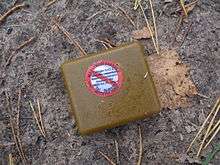Wildlife disease
Wild animals, domestic animals and humans share a large and increasing number of infectious diseases, known as zoonoses.[1] The continued globalization of society, human population growth, and associated landscape change further increase the interactions between humans and other animals, thereby facilitating additional infectious disease emergence.[2][3] Contemporary diseases of zoonotic origin include SARS, Lyme disease and West Nile virus.[4]
.jpg)
Disease emergence and resurgence in populations of wild animals are considered an important topic for conservationists, as these diseases can affect the sustainability of affected populations and the long-term survival of some species.[5] Examples of such diseases include chytridiomycosis, in amphibians; chronic wasting disease, in deer; white-nose syndrome, in bats; and devil facial tumour disease in Tasmanian devils.[6]
Prevention
Culling
Disease outbreaks in wild animals are sometimes controlled by killing infected individuals to prevent transmission to domestic and economically important animals.[7][8] Animal rights advocates argue against culling, as they consider individual wild animals to be intrinsically valuable and believe that they have a right to live.[9]
Vaccination programs

Wild animal suffering, as a result of disease, has been drawn attention to by some authors,[10] who argue that we should alleviate this form of suffering through vaccination programs.[11][12] Such programs are also deemed beneficial for reducing the exposure of humans and domestic animals to disease and for species conservation.[13]
The oral rabies vaccine has been used successfully in multiple countries to control the spread of rabies among populations of wild animals and reduce human exposure.[14] Australia, the UK, Spain and New Zealand have all conducted successful vaccination programs to prevent Bovine Tuberculosis, by vaccinating badgers, possums and wild boar.[15]
In response to the COVID-19 pandemic, it has been proposed that, in the future, wild animals could be vaccinated against coronaviruses to relieve the suffering of the affected animals, prevent disease transmission and inform future vaccination efforts.[16]
External links
References
- Karesh, William B.; Dobson, Andy; Lloyd-Smith, James O.; Lubroth, Juan; Dixon, Matthew A.; Bennett, Malcolm; Aldrich, Stephen; Harrington, Todd; Formenty, Pierre; Loh, Elizabeth H.; Machalaba, Catherine C. (2012-12-01). "Ecology of zoonoses: natural and unnatural histories". The Lancet. 380 (9857): 1936–1945. doi:10.1016/S0140-6736(12)61678-X. ISSN 0140-6736. PMC 7138068. PMID 23200502.
- Patz, Jonathan A.; Daszak, Peter; Tabor, Gary M.; Aguirre, A. Alonso; Pearl, Mary; Epstein, Jon; Wolfe, Nathan D.; Kilpatrick, A. Marm; Foufopoulos, Johannes; Molyneux, David; Bradley, David J. (July 2004). "Unhealthy Landscapes: Policy Recommendations on Land Use Change and Infectious Disease Emergence". Environmental Health Perspectives. 112 (10): 1092–1098. doi:10.1289/ehp.6877. ISSN 0091-6765. PMC 1247383. PMID 15238283.
- Wu, Tong; Perrings, Charles; Kinzig, Ann; Collins, James P.; Minteer, Ben A.; Daszak, Peter (February 2017). "Economic growth, urbanization, globalization, and the risks of emerging infectious diseases in China: A review". Ambio. 46 (1): 18–29. doi:10.1007/s13280-016-0809-2. ISSN 0044-7447. PMC 5226902. PMID 27492678.
- Lipkin, W. Ian (2015). "Zoonoses". Mandell, Douglas, and Bennett's Principles and Practice of Infectious Diseases: 3554–3558. doi:10.1016/B978-1-4557-4801-3.00322-2 (inactive 2020-05-23). PMC 7151852.
- Smith, K. F.; Acevedo‐Whitehouse, K.; Pedersen, A. B. (2009). "The role of infectious diseases in biological conservation". Animal Conservation. 12 (1): 1–12. doi:10.1111/j.1469-1795.2008.00228.x. ISSN 1469-1795.
- Botzler, Richard G.; Brown, Richard N. (2014). Foundations of Wildlife Diseases. Berkeley, California: University of California Press. p. 378. ISBN 978-0-520-27609-3.
- Harrison, Annabel; Newey, Scott; Gilbert, Lucy; Haydon, Daniel T.; Thirgood, Simon (2010). "Culling wildlife hosts to control disease: mountain hares, red grouse and louping ill virus". Journal of Applied Ecology. 47 (4): 926–930. doi:10.1111/j.1365-2664.2010.01834.x. ISSN 1365-2664.
- Cowled, Brendan D.; Garner, M. Graeme; Negus, Katherine; Ward, Michael P. (2012-01-16). "Controlling disease outbreaks in wildlife using limited culling: modelling classical swine fever incursions in wild pigs in Australia". Veterinary Research. 43 (1): 3. doi:10.1186/1297-9716-43-3. ISSN 1297-9716. PMC 3311561. PMID 22243996.
- James, Will (2014-03-06). "Killing Wildlife: The Pros and Cons of Culling Animals". National Geographic News. Retrieved 2020-05-17.
- Tomasik, Brian (2015). "The Importance of Wild-Animal Suffering". Relations: Beyond Anthropocentrism. 3 (2): 133–152. doi:10.7358/rela-2015-002-toma.
- Anthis, Jacy Reese (2015-12-14). "Wild animals endure illness, injury, and starvation. We should help". Vox. Retrieved 2020-05-17.
- Faria, Catia; Paez, Eze (2015). "Animals in Need: The Problem of Wild Animal Suffering and Intervention in Nature". Relations: Beyond Anthropocentrism. 3: 7.
- Abbott, Rachel C. (2020-02-17). "Wildlife Vaccination - Growing in Feasibility?". Cornell Wildlife Health Lab. Retrieved 2020-05-17.
- "Oral Rabies Vaccination". Animal and Plant Health Inspection Service (APHIS). 2019-09-23. Retrieved 12 November 2019.
- Quellette, Cara. "The Case for Wild Animal Vaccination". Nature Ethics. Retrieved 2020-05-17.
- "Helping wild animals through vaccination: could this happen for coronaviruses like SARS-CoV-2?". Animal Ethics. 2020-05-12. Retrieved 2020-05-17.